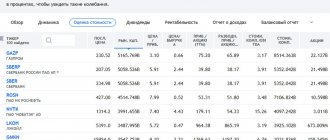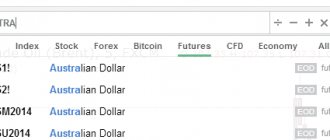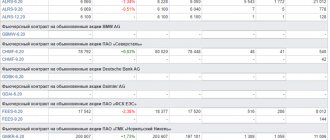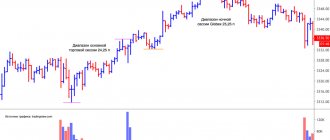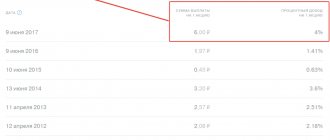What is the volatility of financial instruments?
Volatility is a translation from the English word “Volatility”, which means “volatility”. For stocks, derivatives, currencies and other financial instruments, volatility measures how much an asset's price changes over time.
In simple terms, volatility is an indicator that reflects the variability of the value of a financial instrument over time. If the price changes greatly in a short time, then volatility is considered high. If the changes are small and occur over a long period of time, the volatility is low.
Volatility is measured as a percentage. For developed markets, stock volatility of 5-8% per month is considered normal. Below is low, more is high. In Russia, stock volatility can reach 20% per month, and this is considered the norm, since the Russian stock market is developing.
Volatility reflects the risk of investing in stocks. The higher the volatility, the riskier the investment is considered. After all, volatility works both ways. If its value is 20%, then the stock can go 20% up or 20% down, or, for example, 5% up and then 15% down. Not every investor can handle the nerves of watching such a rally.
At the same time, volatility shows the potential for growth in asset values. All other things being equal, a stock with greater volatility is likely to generate greater capital gains. The fact is that the price for them falls more significantly, therefore, the investor can buy more shares at a lower price.
So, if the price of a conditional Gazmyas falls from 150 to 120 rubles, then with 5,000 rubles in your pocket, you will buy 41 shares. If its volatility is lower and the price drops to 140 rubles, for the same 5,000 rubles you will buy only 35 shares. Well, and accordingly, if the price of a more volatile stock rises, you will earn more, since the price will move upward more powerfully.
Speculators love high volatility - the stronger the amplitude of price movements, the greater their potential earnings. If the stock (or currency pair, if the speculator trades on Forex) is low-volatile, then they will have to make more transactions and, accordingly, pay more commissions in order to ultimately get the same financial result.
And here’s another interesting article: How the stock price is formed and where you can see it
Conservative investors prefer low-volatility assets such as bonds or ETFs because they value stable capital gains over constant price spikes.
Active investors, on the contrary, are attracted only to highly volatile stocks, since they can profitably buy shares when prices sharply decline, and sell them after a sharp increase.
Forex lot size
On the FOREX currency market, the size of one standard lot is 100,000 units of the base currency. This means that in order to make at least one trade on the GBPUSD pair, you will need an amount of 100,000 British pounds. And to trade the USDJPY pair, you will need at least 100,000 US dollars.
Let us remind you that the base currency is the one that stands first in the currency pair. The second currency in the pair is called the quoted currency and it is in it that the price of one unit of the base currency is expressed.
By trading through a broker, you can take advantage of the leverage they provide and purchase a Forex lot for much less money. For example, when using leverage of 1 to 100, you will no longer need 100,000, but 1,000 units of the base currency. And with a leverage of 1 to 1000, it will be possible to buy one lot with only 100 units of the base currency.
But, as you know, using high leverage is fraught with huge risks, which is why many Forex brokers introduce the concept of mini- and microlots:
- A mini lot includes 10,000 units of the base currency;
- A micro lot includes 1000 units of the base currency.
Thus, when trading, for example, micro lots with a deposit of $1,000 or more, you can get by with a small leverage of 1 to 10, which will provide good diversification with a relatively low level of risk.
Many people confuse such concepts as lot and position size, and therefore we often hear, for example, the following question: how to calculate the lot size in Forex? This question sounds extremely incorrect. The lot size, as we have already found out above, is a constant value, but you can (and should) calculate the position size. Read more about how this is done here: “Correctly calculating position size in Forex.”
Types of volatility
Economists usually identify the following types of stock volatility:
- historical – calculated based on standard formulas, shows information about changes in the value of shares over the historical period;
- expected – shows how much the share price may change in the future, taking into account information about the liquidity of the security, the economic situation in the country, investor sentiment, etc.;
- historical expected – demonstrates how the expectation of changes in volatility changed over a certain time period.
The types of volatility are also divided depending on the time period. Calculate daily, weekly, monthly, quarterly and annual volatility.
What does volatility depend on?
Many factors influence stock volatility. I will list the main ones:
- changes in supply and demand;
- carrying out a buyback program, in which large quantities of shares are gradually withdrawn from circulation;
- volume of shares in circulation - if the free-float coefficient is too low, then the demand for shares is also small, and due to low liquidity, volatility also turns out to be modest;
- the economic situation and future prospects of the company;
- dividend policy - if a company declares sudden dividends (or decides not to pay them), then this is sharply reflected in the quotes (especially in Russia);
- external factors - geopolitics, sanctions, rate changes, accidents, explosions, courts, etc.
Volatility is also directly affected by interest in the company. If the company's products (or services) are in demand, and there are many who want to become shareholders, then the actions of market participants will swing the price.
Most often, positive news causes volatility to increase. A striking example is that NKNK shares showed a sharp increase after the company decided to pay dividends for 3 years. Before this, the stock price was moderately hovering around average values, but the news saw an increase of more than 40%. A similar situation was with Gazprom and VTB.
A surge in volatility can also occur against the backdrop of negative news. For example, if a company shows poor reporting or external factors interfere (as in the case of Yandex), then most investors begin to sharply sell the stock - and volatility increases.
It is worth understanding that all of the above applies to stocks. The price of bonds changes for completely different reasons.
And here’s another interesting article: What is a stock ticker: definition and examples
The relationship between liquidity and volatility
Some investors believe that liquidity and volatility are directly related: the more liquid a security is, the higher the volatility. In fact, there is a connection, but it is indirect.
Let me start with the fact that low liquidity and low volatility are indeed related. If a security has a low free-float ratio, this means that there is a limited number of buyers and sellers in the market and they will a priori conduct a small number of transactions.
If the liquidity of a security is high and the free-float ratio is high, then the volatility can be both high and low. It all depends on the above factors and, in general, on the interest in the security on the part of investors and speculators.
For example, the same Central Telegraph has liquidity at a fairly high level, but volatility is not very high: there are no signals for shares to rise, but there are no prerequisites for falls either. But Gazprom, Sberbank, Lukoil and other blue chips of the Russian market are fine with both liquidity and volatility.
On the other hand, if a stock has a low free-float, then one transaction with large capital can significantly move the quotes - and therefore the actual volatility will be high. For example, if you look at NEFAZ shares for the year, you can see that during the year the price fluctuated in a fairly narrow range from 84 to 92 rubles, but in early October there was a sharp increase in quotes with a small volume of transactions - just some large investor made a good purchase. As a result, we have a volatility of 25.58% per year.
Therefore, volatility analysis should not be approached blindly, but rather, the entire context should be analyzed.
Where can you see how much of an asset is included in a lot?
Option 1: In the asset passport on the Moscow Exchange
On the Moscow Exchange website, we go to the passport of the asset we need. In this article we look at lots using the example of blue chips. Therefore, you can find them on the main page of the Moscow Exchange website in the right widget.
In the right widget of the Moscow Exchange we look for the stock we need
And we open the passport, where we can easily find the dimensions of a standard lot of paper.
VTB share passport
For the 10 most popular papers, I have prepared a plate with data on the lot:
| paper | lot | denomination currency |
| Gazprom | 10 | rub |
| Lukoil | 1 | rub |
| Norilsk Nickel | 1 | rub |
| Sberbank (priv) | 10 | rub |
| MTS | 10 | rub |
| Rosneft | 10 | rub |
| NLMK | 10 | rub |
| Novatek | 1 | rub |
| Alrosa | 10 | rub |
| SevStal | 1 | rub |
Option 2: In the Quik terminal
In the Quik terminal you will have a current table of your assets. In this table you can add the necessary parameters for working with assets yourself. One of these important parameters is the lot.
In the current table of parameters, select “lot”
Option 3: In buy/sell orders in Quik
The simplest option. In the order book of the instrument we need, in a simple order, or in a stop order, we look at the standard lot.
We look at the lot through the glass of quotes
And we look at how many shares are included in the lot to calculate the position.
We look at the order for the amount of asset in the lot
How volatility and profitability relate
It may seem that volatility directly affects the profitability of a stock. On the one hand, yes: the higher the volatility, the higher the PROBABILITY of the investor to earn more. But in reality, everything will depend on the goals and objectives of the investment.
If you prefer active investing or speculation, then yes - volatility is your friend, and your earnings will directly depend on the rate of price change. But when making such investments, do not forget that you can buy at the top of the price - and then wait a long time for a reversal. Or you can think that “the bottom is already here” - and receive the second bottom as a gift.
Therefore, the more volatile a stock is, the higher the risks. If you are not ready to accept them, it is better not to include stocks with excessive volatility in your portfolio, but to opt for more conservative options. By the way, the Markowitz portfolio theory also speaks about this, which recommends that an investor choose an instrument with less volatility with the same yield curve. In ETFs for country indices, this rule is implemented as clearly as possible.
And here’s another interesting article: Going abroad: where you can invest abroad
The procedure for calculating the volume of open currency positions
The foreign exchange position of a trader, broker or bank is the relationship between requirements for receiving currency and obligations for its delivery. These liabilities and requirements are calculated either at the reporting date or at the completion of certain future transactions.
There are two types of currency positions: closed and open .
Types of currency positions
Closed type is a position when the volume of obligations and claims are identical, that is, there are no receivables or payables for the transaction. With an open currency position (OCP), the size of the trader’s requirements does not coincide with his obligations. The higher the discrepancy, the greater the risk, other things being equal.
Open positions can be short or long . The former are indicated by a (-) sign and indicate an excess of obligations over receipt requirements. A long position (+) means exactly the opposite.
Calculation of an open currency position is a legal and arithmetic procedure, which is described in Bank of Russia instruction No. 124-I.
How to calculate volatility
There is a special formula for calculating volatility. She looks like this:
B = W / P1/2,
Where:
- W – standard deviation of stock returns;
- P is the calculation period expressed in years.
To calculate volatility using this formula, you need to know the standard deviation of stock returns. Of course, you can calculate it yourself, but it is better to use ready-made solutions.
If I suddenly need to look at the volatility of a particular instrument, then I look at the multiplier value on screeners, for example, here: https://ru.tradingview.com/screener/.
Here you can see the dynamics of price changes for any period, beta and volatility value.
But, as I wrote above, you should not base your conclusions solely on the volatility value. This may be a dead end - instead of an actively traded stock, you may end up with a hard illiquid stock, the price dynamics of which will entirely depend on the actions of large investors.
Thus, stock volatility is the degree to which the price of an asset changes over time. More volatile stocks provide more chances to make money, but there are also more chances to lose money during active speculation. Less volatile stocks provide the opportunity to earn stable income, albeit less. When analyzing volatility, you need to compare it with other ratios, in particular liquidity, and draw conclusions based on all factors so as not to fall into the trap of false growth. Good luck, and may the money be with you!
Rate this article
[Total votes: 2 Average rating: 5]
